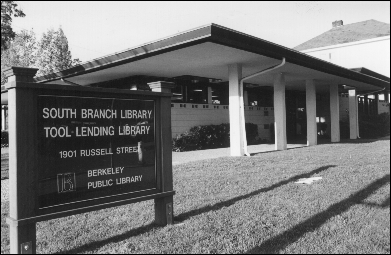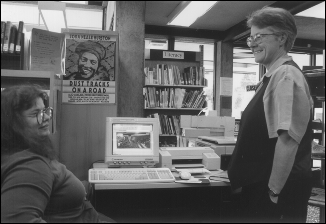
Checking Out The Internet
The story of how community workers are bringing the Internet to everyone. But where's the money?by Andrew Leonard
 All contents © 1995 by
CyberBiz
Productions. All rights reserved.
All contents © 1995 by
CyberBiz
Productions. All rights reserved.Send all comments, corrections or additions to vern@cybertoday.com.

by Andrew Leonard
It wasn't even as if the library system was offering the latest in fancy cyber bells and whistles - Sonoma library access consists of a bare-bones 2400 BPS connection that permits gopher searches and a few other menu-based options. No e-mail, no telnet, no graphics- based World Wide Web-browsing. Still, Sonoma citizens can hold their heads high. As Rosaschi is quick to point, way back in March 1994, the Sonoma County library became the first library in California to offer free Internet access both at library terminals and over dial-up connections.
In California, two legislators have already introduced legislation that includes provisions for requiring that the state subsidize public access to the Internet through public libraries. And hardly a day goes by without some giant telecommunication corporation or computer company offering to hook up schools and libraries to the Internet.
But in a state that currently ranks fiftieth in the country in terms of library hours open per capita, money is scarce. Hardware upgrades, training for Internet-challenged librarians, and access fees add up quickly. The hundreds of public libraries rushing to follow Sonoma's example and turn their library into an infobahn "information hub" have been forced to cobble together funding from a myriad of sources, ranging from Kiwanis Club fundraisers to federal government grants. And there's been a corresponding variation in what libraries have to offer in the way of access - hardly any two libraries boast the same mix of walk in, dialup, gopher, WWW, FTP, or e-mail. Like the Internet itself, public library access is a crazy-quilt of many colors.
At one end of the scale there is the Peninsula Library System, a coalition of 32 public libraries and community colleges in San Mateo County which will be offering World Wide Web access with Netscape browsers beginning in mid-April. According to Frank Vaskelis, director of information technology services at San Mateo Community College, the participating libraries have been able to avoid depending on either the private secotor or government grants. After completing a complete "recabling" of every partiicpating library as part of an upgrade to a new library automation network, funded by individual library membership fees, each library has a speedy internal 56K system connected by a T-1 line to BARRNET, a local Internet access provider.
The money comes from the federal Department of Education's Library Services and Construction Act, and in California it has been designated for the purchase of 486 workstations equipped with modems, ten days of training time, and 100 hours of free connect time with an Internet Service Provider.
A good example of what's possible with the relatively small amount of financial support provided by the InfoPeople project - about 15,000 dollars per library. Berkeley has established stand-alone workstations equipped with 9600 modems running Netscape all four of its branches. Berkeley was the first public library in California to set up its own World Wide Web home page, "the Cadillac of public library home pages" according to one librarian.
 Even recipients of InfoPeople funds still need additional resources to
get their patrons on the Internet. "What we at Berkeley Public need
more of is time and money. I need money to upgrade our machines
from 4 to 8 megs and the modems 9600 to 14.4," said Berkeley reference
librarian Carole Leita.
Even recipients of InfoPeople funds still need additional resources to
get their patrons on the Internet. "What we at Berkeley Public need
more of is time and money. I need money to upgrade our machines
from 4 to 8 megs and the modems 9600 to 14.4," said Berkeley reference
librarian Carole Leita.
The Alameda, Marin, Contra Costa, and Santa Clara County libraries, and libraries in Palo Alto, San Jose, Redwood City, Hayward, and Sunnyvale have all received InfoPeople funding and are in various stages of making services available to the public. A spokesperson for the Alameda County Library, which has branches in Fremont, Pleasanton, Castro Valley, Union City and San Lorenzo, reported that their machines were constantly busy. Library policy allows library members to reserve workstation access for a maximum of an hour a week.
Interestingly, neither the Oakland nor San Francisco public libraries are participating in the InfoPeople project. Carl Cousineau, administrative librarian at the Oakland Public Library, said that the InfoPeople emphasis on standalone machines did not fit into the library's overall plans for providing extensive dial-up connectivity and access to city government services.
 "What the city of Oakland is trying to do, is to, number one, give our
citizens access to the Internet," said Cousineau, "but also to go
beyond that, and give a means so that citizens can talk to government.
The city intends to put up a web surfer and gopher server, and the
library will be just a piece of the overall picture, a connection for
local citizens to get out into the world." Oakland's current provision
of gopher and FTP access was made possible through the library's own
general fund.
"What the city of Oakland is trying to do, is to, number one, give our
citizens access to the Internet," said Cousineau, "but also to go
beyond that, and give a means so that citizens can talk to government.
The city intends to put up a web surfer and gopher server, and the
library will be just a piece of the overall picture, a connection for
local citizens to get out into the world." Oakland's current provision
of gopher and FTP access was made possible through the library's own
general fund.
The San Francisco Public Library has secured numerous other sources of funding, although it has yet to actually offer any form of Internet access to the general public. Last year, the SF Library received a $425,000 National Telecommunications Information and Administration (NTIA) grant, part of a 50 million dollar federal Department of Commerce program designed to "promote the effective use of a modern, interactive National Information Infrastructure (NII) by the public and the non-profit sector at the local level." The NII initiative was established by the Clinton Administration in 1993 to fund an ambitious use of public funds to create Al Gore's mythical Information Superhighway.
The 1994 grant, said McBride, was for establishing databases of city, neighborhood, and community organization information that will be accessible to the public through the San Francisco CityLink program. A coalition effort by the SF library, KQED, San Francisco State University, cable channel 54, the Exploratorium, and the online conferencing service The Well, CityLink is an ambitious plan to create a community network that will provide full Internet access to the public.
San Francisco has also received a Corporation for Public Broadcasting grant for the purpose of developing its resources in a format friendly to children and educators, as well as a private Library Foundation grant aimed specifically at developing Internet connectivity. McBride predicted that library patrons would be able to access Internet services through the San Francisco Public Library sometime "between now and the fall."
In San Jose, a consortium of blue chip organizations called Smart Valley Inc., a coalition of "technology providers, services providers, application developers and end users" has set up the Smart County Public Access Network to install public access sites and, some of which will be located in public libraries.
But perhaps the most ballyhooed private sector initiative has been Pacific Bell's offer to install high speed ISDN (Integrated Services Digital Network) in every school, library, and community college in California. Titled Education First, the hundred million dollar program aims to install up to four ISDN lines in each library or school, and waive usage fees for the first year. PacBell also is offering free inside wiring, has applied to the PUC for the right to offer a discounted "Knowledge Network" flat rate for usage fees, and says that it is also negotiating with vendors to achieve substantial hardware and service discounts for schools and libraries.
Most Bay Area libraries are taking a wait and see approach to PacBell's ISDN offer. They're concerned that that the hardware costs associated with getting set up to take advantage of ISDN lines could be signifcant, and they worry that "carrying the freight" for ongoing expenses associated with usage fees might be too much for small libraries to bear. There's also a feeling that ISDN technology is already "old" technology, and that Education First is actually little more than a marketing ploy to stir up public interest. For libraries such as the Santa Clara County Library that have already established frame relay connections to the Internet, installing ISDN would be a step backward, though Pacific Bell representatives note that there are other uses for ISDN, such as tele-conferencing, that aren't possible with frame relay.
The final deadline for submitting applications to participate in Education First isn't until the end of 1996. That's a long long time in cyberspace, noted Oakland's Cousineau, and he echoed the sentiments of numerous other Bay Area libraians when he said that he was keeping his options open.
"The thing about this whole NII movement is that everybody is learning as they go," said Sybil Boutilier, the San Francisco Public Library's CityLink coordinator. "I don't care if you're Silicon Graphics or Pacific Telesis or a student in fourth grade, everybody is learning on the fly, the services are being developed so fast, the whole direction is being determined in a very organic way. Like the way a river flows, and it's sort of in a flood stage right now, in terms of the creation and development of new services. It's like a big migration, towards this virtual global community and everybody's on the same road, moving along the road, floating down the river. It's been quite wonderful to see - the huge powerful organizations like the telephone companies, like some of the major computer manufacturers and the public organizations like the library and the colleges, and little tiny organizations like Glide Memorial Church's Computers and You, a whole range of organizations of every type and culture are all trying to accomplish similar goals."